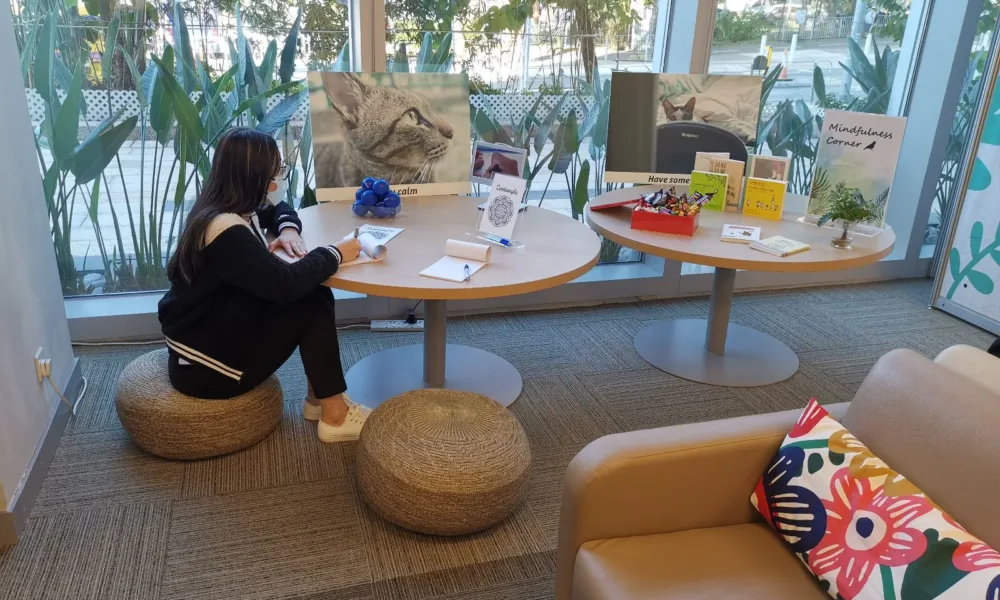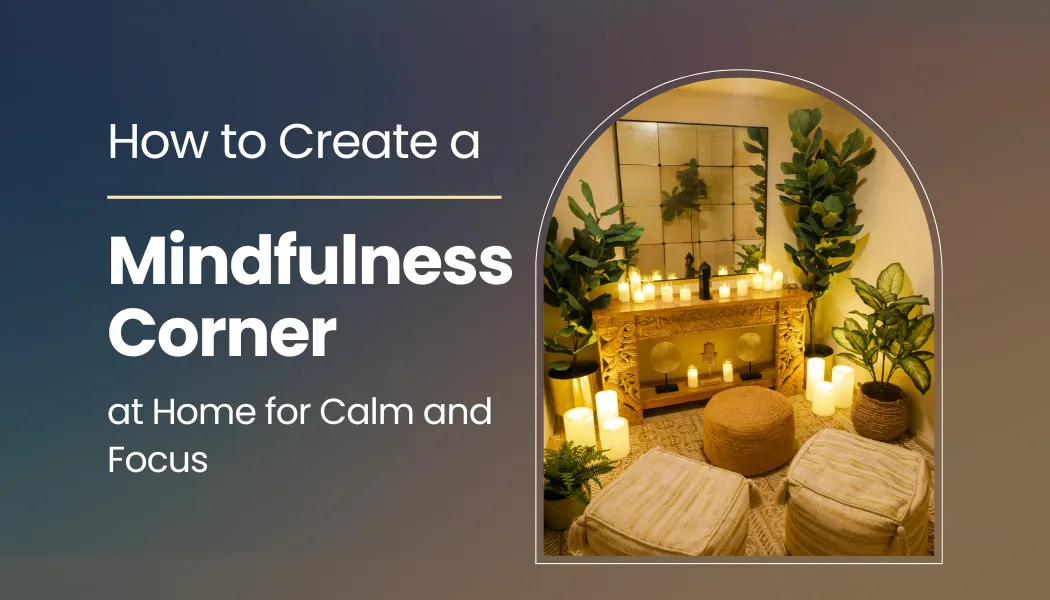In the chaos of modern life, finding a moment of calm can feel impossible. With constant notifications, work pressures, and daily responsibilities, mental clutter builds up quickly. A personal mindfulness corner at home provides a dedicated space to pause, reflect, and reconnect with yourself.
Unlike a general relaxation area, a mindfulness corner is intentionally designed to encourage meditation, deep breathing, and mental clarity. It becomes your personal sanctuary—a place where you can unplug, recharge, and practice self-care daily.
This article will guide you step by step on how to design, set up, and maintain your own mindfulness corner, ensuring it becomes a functional, inspiring, and restorative part of your home.
Table of contents
- Why You Need a Mindfulness Corner
- Choosing the Right Space
- Essential Elements of a Mindfulness Corner
- Setting Up Your Mindfulness Corner
- Mindfulness Practices in Your Corner
- Maintaining Your Mindfulness Corner
- Benefits of a Personal Mindfulness Corner
- Tips for Success
- Mindfulness Corner for Families
- Integrating Technology Mindfully
- Making It a Lifestyle Habit
- Conclusion
Why You Need a Mindfulness Corner
Before diving into the setup, it’s important to understand why a dedicated space matters:
- Promotes Consistency: Having a fixed spot reminds your mind and body that it’s time for mindfulness practice, creating a habit loop.
- Reduces Stress: A tranquil corner helps reduce cortisol levels and promotes relaxation.
- Enhances Focus: By minimizing distractions, your brain can concentrate fully on meditation, journaling, or deep breathing.
- Supports Mental Health: Regular mindfulness practice improves emotional regulation, lowers anxiety, and fosters resilience.
- Boosts Creativity: Calm spaces often inspire new ideas, problem-solving, and reflection.
A mindfulness corner is more than décor—it’s a mental reset station, a place that nurtures both emotional and cognitive health.
Choosing the Right Space
Selecting the perfect spot in your home is the first step:
- Quiet Corner: Choose a location away from noise, heavy foot traffic, or distractions. Bedrooms, spare rooms, or even a balcony can work.
- Natural Light: If possible, position the space near a window. Sunlight naturally uplifts mood and energy levels.
- Ventilation: Fresh air enhances alertness and relaxation.
- Size: Even a small 2×2 meter area is enough; mindfulness doesn’t require much space.
Remember, this space should feel safe, comfortable, and private, a mini sanctuary where you can retreat without interruptions.
Essential Elements of a Mindfulness Corner
A mindful space is defined by the items and ambience that support calm, focus, and intentional practice:

1. Comfortable Seating
- Meditation Cushion (Zafu): Supports proper posture during meditation.
- Yoga Mat or Soft Rug: Adds comfort for floor-based practices.
- Chair with Back Support: For those who prefer seated meditation, a sturdy chair works well.
2. Soft Lighting
- Natural Lighting: Maximize daylight exposure.
- Warm Lamps or String Lights: Creates a cozy, serene atmosphere in the evening.
- Candles or Tea Lights: Provides gentle flickering light that aids relaxation.
3. Nature Elements
- Indoor Plants: Promote air purification and a calming environment.
- Water Features: Small fountains or aquariums add soothing sound.
- Natural Materials: Wooden furniture, stones, or woven baskets enhance a grounding effect.
4. Aromatherapy
- Essential Oils: Lavender, sandalwood, or eucalyptus can enhance relaxation.
- Incense or Smudge Sticks: Used for rituals or mindful breathing exercises.
- Diffusers: Maintain a gentle fragrance without overwhelming the senses.
5. Personal Touches
- Journals or Notebooks: For mindful writing and reflection.
- Inspirational Quotes: Remind you of calm, positivity, and intention.
- Art or Sculptures: Minimalistic and calming visuals foster a meditative mood.
Setting Up Your Mindfulness Corner
Step 1: Clear the Space
- Remove clutter or items unrelated to mindfulness.
- Keep surfaces clean and organized, as mess can distract the mind.
Step 2: Define the Zone
- Use a rug, mat, or low table to demarcate the area.
- Place your cushion or chair at the center.
Step 3: Add Comfort and Texture
- Layer cushions, blankets, or floor mats for comfort.
- Include soft fabrics to invite relaxation.
Step 4: Incorporate Nature
- Position plants near natural light sources.
- Add a small water feature for ambient sound.
Step 5: Enhance Ambience
- Install soft lighting: lamps, fairy lights, or candles.
- Add calming scents via diffusers or incense.
Step 6: Personalize
- Place your journal, meditation tools, or inspirational items.
- Consider a small shelf for books on mindfulness, yoga, or self-improvement.
Mindfulness Practices in Your Corner
Having a dedicated space encourages consistent practice. Here are key practices to integrate:
1. Meditation
- Breathing Meditation: Focus on inhale and exhale to center attention.
- Guided Meditation: Use apps or recordings for structured practice.
- Mindful Observation: Focus on one object in your space and explore it with full attention.
2. Journaling
- Reflect on your day, thoughts, and emotions.
- Practice gratitude journaling by listing things you appreciate.
3. Yoga or Stretching
- Short yoga flows can awaken the body while calming the mind.
- Focus on slow, deliberate movements paired with deep breathing.
4. Mindful Reading
- Read books or articles that inspire calm, positivity, or personal growth.
- Avoid screens or notifications during this time.
5. Breathing Exercises
- Box Breathing: Inhale for 4 counts, hold for 4, exhale for 4, hold for 4.
- Alternate Nostril Breathing: Balances nervous system and reduces stress.
Maintaining Your Mindfulness Corner
Regular Cleaning
- Keep the area tidy to avoid mental distraction.
- Replace water in fountains or refresh plants as needed.
Seasonal Adjustments
- Rotate cushions, blankets, or décor to keep the space fresh.
- Adjust lighting or scents according to seasons and moods.
Re-evaluate Your Needs
- Your mindfulness corner should evolve with your practice.
- Remove items that no longer serve your mindfulness journey.
Benefits of a Personal Mindfulness Corner
Creating a mindfulness corner has measurable benefits for mental, emotional, and physical health:
- Reduced Stress and Anxiety: Regular practice lowers cortisol and calms the nervous system.
- Improved Focus and Productivity: Brief daily sessions enhance attention and cognitive clarity.
- Better Sleep Quality: Evening mindfulness routines promote relaxation for restful sleep.
- Emotional Regulation: Practicing awareness improves response to challenging situations.
- Enhanced Creativity: Calm spaces foster imaginative thinking and problem-solving.
Research consistently shows that dedicated mindfulness spaces improve the frequency and quality of mindfulness practices, amplifying these benefits.
Tips for Success
- Consistency Over Duration: Even 5–10 minutes daily is impactful.
- Disconnect Digitally: Keep phones or gadgets out of the corner.
- Start Simple: Begin with basic breathing or meditation before adding complex practices.
- Celebrate Small Wins: Notice improvements in calmness, focus, or mood.
Mindfulness Corner for Families
A mindfulness corner doesn’t have to be solitary. Families can:
- Create a shared meditation or reading corner for quiet time.
- Encourage children to engage in mindful drawing or coloring.
- Use it for family gratitude sessions, enhancing emotional bonds.
This transforms mindfulness into a collective habit, nurturing emotional well-being for all members.
Integrating Technology Mindfully
While mindfulness encourages unplugging, technology can support your practice:
- Guided Meditation Apps: Headspace, Calm, or Insight Timer.
- Ambient Sound Machines: Simulate natural environments for focus.
- Mindfulness Reminders: Gentle notifications to practice short sessions.
Remember, tech should support—not dominate—your mindfulness corner.
Making It a Lifestyle Habit
Your mindfulness corner should be more than a space—it’s a ritual:
- Establish a routine: morning meditation, midday pause, or evening reflection.
- Track progress in a mindfulness journal.
- Gradually expand practices: add breathing exercises, body scans, or gratitude rituals.
Over time, the corner becomes a mental anchor, a safe retreat during stressful periods.
Conclusion
Creating a personal mindfulness corner at home is a transformative act. It provides a physical and psychological sanctuary where calm, focus, and self-awareness flourish. By carefully selecting the space, adding comfort and nature elements, and integrating daily mindfulness practices, you cultivate mental resilience, emotional balance, and inner peace.
In a world that constantly demands attention, your mindfulness corner becomes a personal refuge, helping you navigate daily life with clarity, calmness, and purpose. Whether you spend five minutes or fifty, the space nurtures your well-being, creativity, and happiness—making it one of the most valuable investments you can make in your home and your mind.
